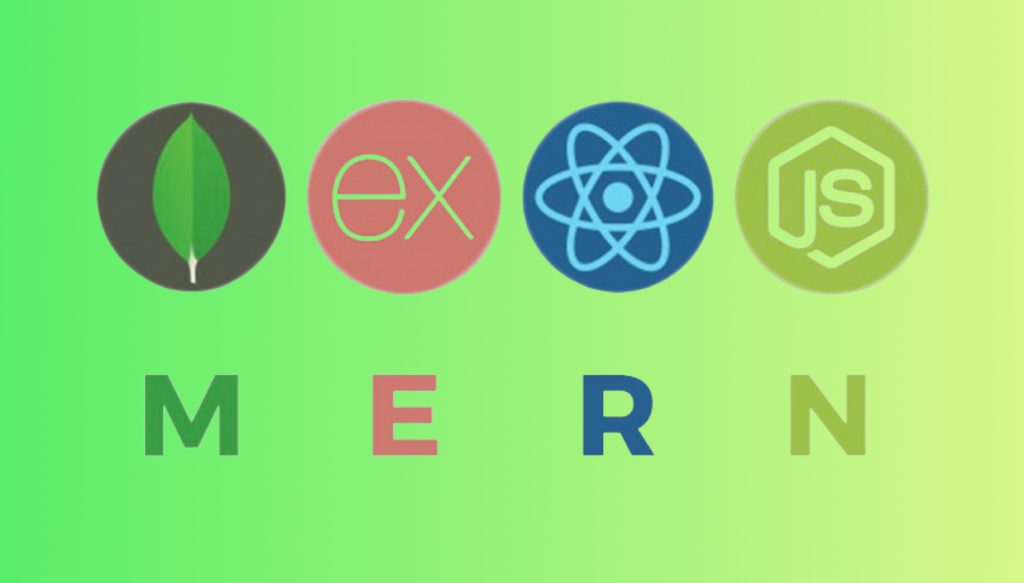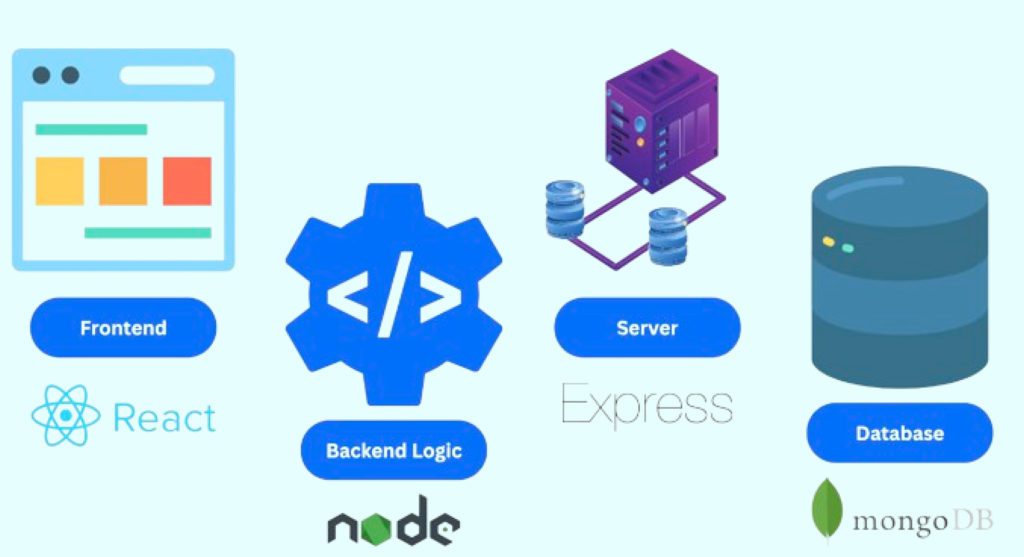MERN Stack Can Hack and change lagging Industries!
MERN Stack Can Hack and change lagging Industries!
MERN stack Introduction:
The MERN stack is a fundamental component of modern web development that has completely changed the creation and implementation of online applications. The MERN stack gives developers a complete, end-to-end solution for project efficiency, scalability, and customisation. It consists of MongoDB, Express.js, React.js, and Node.js. MongoDB is a NoSQL database that offers remarkable flexibility in terms of data handling. Express.js is a lightweight web application framework, built using Node.js, that offers a stable foundation for creating server-side applications.
Facebook created the dynamic JavaScript library React.js, which is used to create interactive user interfaces. In the meantime, Node.js, which is built on top of the V8 JavaScript engine found in Chrome, gives developers access to server-side execution, ensuring seamless client-server communication.
Effective web development frameworks like MERN are essential in the modern digital world, where user experience, scalability, and performance are paramount. They expedite time-to-market, optimise development workflows, and provide the flexibility required to adjust to changing project needs. The importance of frameworks like MERN cannot be emphasised as companies seek to remain competitive and provide cutting-edge online experiences. These frameworks allow developers to design complex apps that satisfy the needs of both modern customers and businesses.

Understanding the MERN Stack
The four components of the MERN stack—MongoDB, Express.js, React.js, and Node.js—are critical to modern web development. MongoDB is a NoSQL database known for its scalability and flexibility, which enable efficient data management. Express.js, a lightweight and versatile web application framework for Node.js, makes server-side programming easier with its simple architecture. Facebook’s React.js is a powerful JavaScript framework that can be used to build dynamic and interactive user interfaces that improve the user experience. Node.js, on the other hand, enables developers to run JavaScript code on the server side while ensuring seamless client-server communication via Chrome’s V8 JavaScript engine.
Together, these components create trustworthy online applications. MongoDB provides a scalable database foundation, and Express.js simplifies server-side routing and logic. React.js maintains the user interface on the client side, offering responsiveness and interaction via its component-based architecture. Node.js acts as the backbone, allowing for quick request processing and real-time communication. These technologies work well together to provide a unified stack that enables developers to construct feature-rich, scalable, and high-performance online programmes that satisfy the demands of both companies and modern customers.
Advantages of the MERN Stack
The MERN stack’s numerous features contribute to its widespread adoption and success in current web development.
To begin, one of the most significant benefits of the MERN stack is its scalability. MongoDB’s NoSQL nature allows for easy horizontal scaling to meet rising data demands. Express.js and Node.js provide a non-blocking, event-driven design that can effectively handle concurrent connections, ensuring that applications remain responsive even during peak demand.
Another key benefit of using JavaScript consistently throughout the stack is increased efficiency. The ability to seamlessly transition between client-side and server-side code reduces the need for developers to switch between environments or languages. This reduces the time-to-market for web apps by simplifying the development process and lowering expenses.
The MERN stack’s modular design promotes flexibility by allowing developers to choose the best tools and libraries for their specific applications. Developers may personalise their tech stack by adding third-party APIs or using a different database solution.
Node.js enables real-time updates, while WebSocket support enables bidirectional communication between clients and servers. Applications requiring real-time data updates, such as chat programmes or collaborative applications, must provide this capability.
Last but not least, the MERN stack includes a vibrant community that offers a diverse set of libraries, frameworks, and tools. Developers may use this community to solve issues faster, exchange ideas, and create faster by leveraging best practices and reusable components.
Applications Across Industries
The MERN stack’s robustness and versatility make it beneficial in a range of industries, all of which benefit from its unique characteristics.
The MERN stack provides e-commerce systems with dynamic features such as customised recommendations and real-time inventory updates. E-commerce websites employ React.js for front-end interfaces and Node.js for server-side operations to deliver a seamless user experience and efficient transaction processing.
The MERN stack’s features are used by social media businesses to create dynamic user interfaces and handle enormous volumes of data. React.js enables rapid dynamic content rendering, while MongoDB’s scalability improves platform performance and user engagement by ensuring smooth data storage and retrieval.
The MERN stack is used by healthcare apps to handle patient information, organise appointments, and offer telemedicine. The stack’s real-time capabilities enable healthcare practitioners to give quick care while optimising administrative tasks, resulting in improved patient outcomes and operational efficiency.
Security is critical in the financial business, and the MERN stack addresses that need. Financial applications protect the integrity and security of transactions using rigorous authentication mechanisms and encrypted data processing. Furthermore, the stack’s agility facilitates data analysis, allowing financial institutions to get analytical insights for risk management and informed decision-making.
Case Studies
A number of well-known organisations have chosen the MERN stack, capitalising on its ability to produce innovative solutions and improve their online exposure. Facebook is one example of a company that primarily employs React.js for its user interface and provides a seamless and responsive experience to billions of consumers worldwide. Despite its massive scale, Facebook’s platform has maintained high performance and scalability because to the MERN stack’s modular architecture.
Another excellent example is Netflix, which runs its streaming service on the MERN stack. Netflix’s backend is built on Node.js to provide smooth streaming and real-time adjustments, allowing it to serve high-quality video content to millions of users at once. Netflix has retained its position as the streaming market leader by delivering unprecedented advancements in user experience through the use of React.js to create engaging interfaces and MongoDB to store vast amounts of user data.
Furthermore, Airbnb, a market leader in the sharing economy, uses the MERN stack to deliver seamless booking experiences for millions of customers worldwide. Airbnb has effectively addressed scalability and performance challenges by leveraging React.js for dynamic frontend experiences and Node.js for server-side operations. This has enabled Airbnb to provide consumers an easy-to-use platform for locating and booking accommodations.
These case studies show how the MERN stack can assist firms in a number of industries overcome various challenges and create high-performing, scalable, and user-focused web solutions.
Future Trends and Innovations
The MERN stack has a promising future as a slew of new developments and trends transform its environment. One significant breakthrough is the use of serverless architectures, which enable applications to be created and delivered without requiring server infrastructure administration. This paradigm provides more scalability, fewer overhead, and shorter development cycles. Progressive online applications (PWAs) are also gaining popularity, providing users with a native app-like experience while employing internet technologies. Many developers choose to utilise PWAs because they provide perks like push alerts, offline access, and quicker loading times.
Technology breakthroughs like as GraphQL are also influencing how the MERN stack will evolve in the future. GraphQL improves productivity and lowers network costs by providing clients with direct access to the data they require. WebAssembly also allows MERN programmes to execute code written in languages other than JavaScript, providing further potential for speed optimisation and code reuse.
The MERN stack is expected to continue increasing and being more extensively utilised in a range of industries in the future. Its ability to create scalable, adaptive, and efficient solutions aligns well with the evolving requirements of web development.
The MERN stack has a promising future as a slew of new developments and trends transform its environment. One significant breakthrough is the use of serverless architectures, which enable applications to be created and delivered without requiring server infrastructure administration. This paradigm provides more scalability, fewer overhead, and shorter development cycles. Progressive online applications (PWAs) are also gaining popularity, providing users with a native app-like experience while employing internet technologies. Many developers choose to utilise PWAs because they provide perks like push alerts, offline access, and quicker loading times.

Conclusion
The MERN stack, which combines powerful technologies like MongoDB, Express, React, and Node.js, has a big influence on the web development business. This blog post emphasised its significance by discussing how Node.js ensures seamless client-server communication, Express.js provides a robust server-side framework, React.js allows for dynamic user interfaces, and MongoDB provides flexible data management.
The essay also underlined the importance of the MERN stack to the web development revolution, as it enables the efficiency, scalability, and adaptability required in today’s digital world. Its applications span industries, from e-commerce to healthcare, promoting innovation and enhancing user experiences.
Finally, it is evident that developers who wish to remain at the forefront of web development must embrace the MERN stack. It is critical owing to its efficient procedures, short time-to-market, and flexibility in reacting to changing project requirements. It is consequently advised that readers look into and adopt the MERN stack for their next web development project. Businesses benefit not just from cutting-edge technologies, but also from improved web experiences and more innovation in a range of industries.


